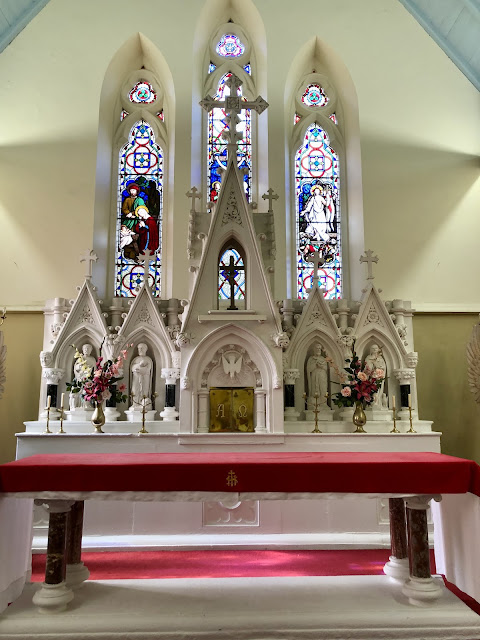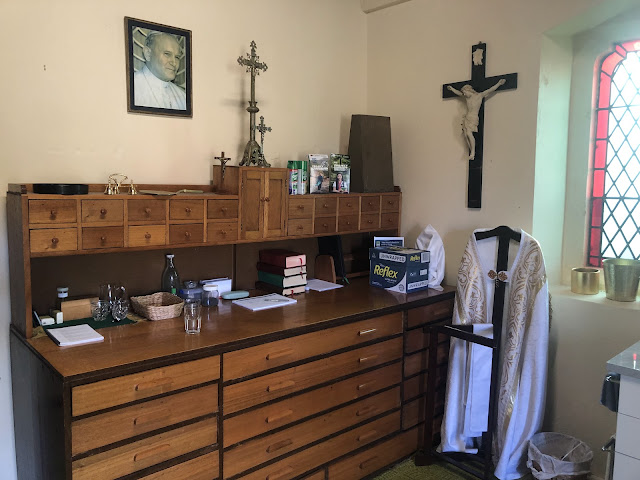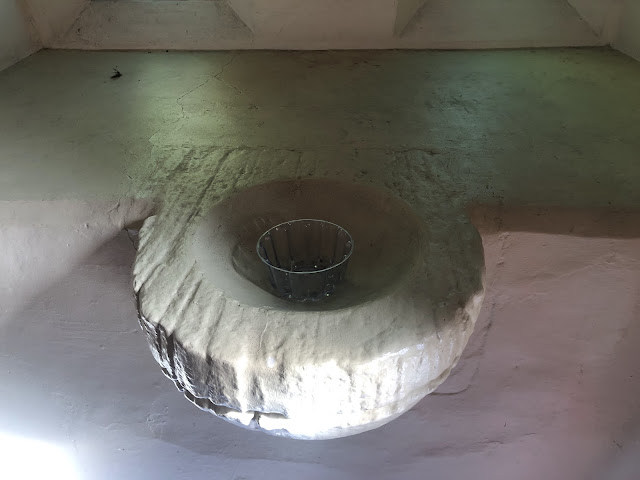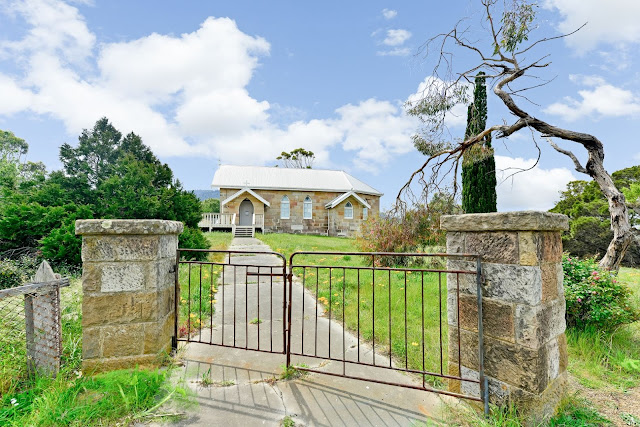No. 230 - Westbury - Holy Trinity Catholic Church "Father Hogan's Feasts"
The founding of Holy Trinity Catholic Church at Westbury is closely bound up with the life of Father James Hogan.
The first regular Catholic Masses at Westbury can be dated back to 1847 when the Government permitted Catholics to use the Colonial Hospital ‘for divine service’ for Westbury and the surrounding districts.
In 1850, Bishop Robert Willson asked for a Government land grant at Westbury on which to build a church, a priests house and school. This was approved on condition that the Catholics built their church as soon as possible. Father Hogan, who was to serve the Catholics of the Westbury district for 49 years, arrived in the town in a fisherman’s cart on May 24, 1850.
In 1855, a small timber church was built at a cost of £300. Within seven years of Hogan’s appointment, the Catholic population of the Westbury region had grown to 1400. By 1868, this had increased to about 2000, only 100 fewer than Launceston.
The rapid growth of the church is illustrated in reports of large numbers of adults and children undertaking the sacrament of confirmation. In 1863, The Cornwall Chronicle reported on one such event involving 115 children and adults:
“The ceremony was a most imposing one, and witnessed by certainly not less than about 1100 or 1200 persons, amongst whom were not a few representatives of other denominations. The persons to be confirmed had assembled from the thee districts of Longford, Deloraine and Westbury…”
By the 1870’s large confirmation services had become a feature of Westbury’s religious life. In January 1878, the Launceston Examiner reported on what had become a popular annual spectacle:
“The children…. had their annual examination in church doctrine. Between 400 and 500 of them were examined, and prizes presented by their respected pastor, the Rev. J. Hogan, after which headed by the Westbury Band they walked in procession round the township, halting at the old Catholic Church, where they were most liberally regaled with tea and cakes. After the children had satisfied their little wants the doors were thrown open to children and grown people of all denominations. The amount of feasting was something tremendous, still there appeared to be enough for all and to spare…. It seems a real pleasure to Father Hogan to see the members of his flock and others of different denominations assembled in friendly and social intercourse… [and] “Father Hogan’s feast,” as it is termed, is looked forward to from year to year, by young and old, as one of the most enjoyable events in our little community”.
The growth of the Catholic community necessitated the need for a much larger church. The foundation stone of the Holy Trinity Church was laid on 12 May 1869. The Examiner reported on the event that was attended by four bishops:
“The ceremony of laying of the foundation stone of the Church of the Most Holy Trinity, … took place today…. On the grounds were a large marquee, upwards of 200 feet long, well filled with the good things of life…. From an early hour vehicles, horsemen, pedestrians, &c, were wending their way to the scene of the ceremony…. Precisely at 12 o’clock the procession left the Catholic Church, consisting of the Right Rev. Dr. Murphy, Bishop of Hobart Town, the Right Rev. the Bishop of Brisbane, Queensland, the Right Rev. the Bishop of Bathurst, New South Wales, the Right Rev. the Bishop of Maitland… The Bishop of Brisbane, who delivered the address on the occasion, … delivered one of the most instructive and touching addresses, clothed in the most simple language suited to the capacities of everyone present”.
The church took five years to complete and was finally opened in May 1874. The event was widely covered by Tasmanian newspapers. The Examiner, as was typical of newspapers of the time, was fascinated with the dimensions and structural details of the new church:
“Erected from plans designed by Mr Henry Hunter, architect, of Hobart Town. It is plain Gothic, built of stone, and calculated to seat comfortably 800 persons, not too large for the expected requirements of the congregation. It contains a Nave, seventy-six feet by thirty-one feet; two Transepts, each twenty-three feet by thirteen feet; Sacristy, eighteen feet by fourteen feet; Tower Entrance, nine feet by nine feet; Baptistery, ten foot by ten foot; Lobby ten foot by ten foot; … The Organ Gallery, which is at the west end, extends the whole width of the Nave; … being lighted by a very beautiful oriel window of stained glass…. The walls are built of squared rubble ironstone in irregular courses, with freestone dressings from stone procured in the district…. The old altar (Gothic) is to be used at present until a better and a more suitable one is furnished”.
The tower was yet to be completed and was temporarily covered. The architect's plan intended the tower to stand at height of 71ft and to be caped with a spire reaching a total height of 104ft. Although the tower was completed after the turn of the century, the spire was never built.
Large numbers of people arrived by train from Deloraine and a special train was put on from Launceston for the opening on Wednesday 20 May. As was typical of Westbury and Father Hogan, it was an ecumenical affair. According to The Cornwall Chronicle:
“The orchestra and choir, we may mention, was composed of ladies and gentlemen…who kindly offered to assist at the opening ceremony, many of them not belonging to the Roman Catholic denomination, but such is the respect in which Father Hogan is held by all classes, that persons in and outside his church have vied with each other in assisting him, not only at the opening ceremony, but in a more substantial way of money donations towards defraying the cost of the building”.
Father Hogan continued to minister at Westbury until his death in 1899. Following the opening of Holy Trinity, in 1887 he invited the Sisters of St Joseph to open a convent and school in the parish. This will be a focus of a second blog entry on the Holy Trinity Church.
In accordance with his wishes, Father James Hogan lies buried inside Holy Trinity Church. In 1901 the church tower was completed as a memorial to Father Hogan. The cost of the tower and clock was contributed to by all the denominations of the town, which is in itself a fitting tribute to a man so deeply respected.
An extract from Father James Hogan’s obituary
The Venerable James Hogan was a native of Kilkenny, Ireland, and was born on July 24, 1825. He received his ecclesiastical education at St. Kyran's College, in his native place, and before taking holy orders, in 1848, took ship for Tasmania, in company with the late
Archdeacon Marum, of Brighton, and Father Keoghan, of Oatlands. All three came out as secular gentlemen, and shortly after arrival, subsequent to some preliminary examinations, they, with Archdeacon Hunter were ordained to the priesthood at St. Joseph's Church, Hobart, by the late Right Rev. Bishop Willson, the first Bishop of Hobart. That took place on March 31, 1850. Father Hogan was sent north, in charge of the Westbury mission, on May 24, 1850, and remained there until his death.
In those days very different conditions prevailed to those at present existing. There were few roads, and a great deal of cross-country travelling to do over a parish which then embraced Westbury, Longford, and Deloraine. The young priest entered upon his duties with zeal and industry. His knowledge of horsemanship here stood him in good stead, for he was an accomplished rider, with an unrivalled nerve and pluck. No obstacle interfered with his parochial visitations; no road was too rough; no bush country too difficult for him and his horse to traverse. He speedily became familiar with his extensive parish, and gained the confidence and esteem of his flock, who appreciated his earnestness of purpose and the vigour with which he carried out his work. At that time Father Hogan held service at West bury in a small wooden building, which now forms part of the Convent School. He speedily resolved to obtain a better place of worship, and it was by his indefatigable exertions that the noble edifice of the Church of the Most Holy Trinity was erected. This building is of bluestone, and next to the Church of the Apostles, at Launceston, is considered the finest Roman Catholic church in the north….
Some years ago, in recognition of his services to the church, and his missionary zeal, Father Hogan was elevated to the dignity of Archdeacon by the present Venerable Archbishop of Hobart, the Most Rev. Dr. Murphy, and the well-deserved honour was the cause of much rejoicing among his loving parishioners. In 1887 the deceased gentleman, whose health was failing, applied for and was granted leave of absence, and he took a holiday trip to Europe, visiting of course the land of his birth, and gazing for the last time upon the hallowed spots familiar to him from boyhood. … He returned to Tasmania in much better health and with renewed vigour, to the great delight of the residents of the district…. In person the deceased gentleman was a tall, handsome man, of splendid physique. Of late years he permitted his beard to grow, in accordance with medical advice, and his tall, commanding figure and venerable appearance at once attracted attention. Personally he was one of the best-loved and most respected dignitaries of the church. His disinterested zeal, his devotion to church work, his attention to details of organisation and management, his genial, kindly, social disposition, and his warm-heartedness endeared him to his parishioners, and gained him hosts of true friends outside the pale of his own denomination. He was one of the best known and most esteemed clergymen in the island, and his memory will be revered for generations to come. The Archdeacon was at once a devout priest, a faithful and warm friend, and a true gentleman. [Launceston Examiner Friday 8 September 1899]
The first regular Catholic Masses at Westbury can be dated back to 1847 when the Government permitted Catholics to use the Colonial Hospital ‘for divine service’ for Westbury and the surrounding districts.
In 1850, Bishop Robert Willson asked for a Government land grant at Westbury on which to build a church, a priests house and school. This was approved on condition that the Catholics built their church as soon as possible. Father Hogan, who was to serve the Catholics of the Westbury district for 49 years, arrived in the town in a fisherman’s cart on May 24, 1850.
In 1855, a small timber church was built at a cost of £300. Within seven years of Hogan’s appointment, the Catholic population of the Westbury region had grown to 1400. By 1868, this had increased to about 2000, only 100 fewer than Launceston.
The rapid growth of the church is illustrated in reports of large numbers of adults and children undertaking the sacrament of confirmation. In 1863, The Cornwall Chronicle reported on one such event involving 115 children and adults:
“The ceremony was a most imposing one, and witnessed by certainly not less than about 1100 or 1200 persons, amongst whom were not a few representatives of other denominations. The persons to be confirmed had assembled from the thee districts of Longford, Deloraine and Westbury…”
By the 1870’s large confirmation services had become a feature of Westbury’s religious life. In January 1878, the Launceston Examiner reported on what had become a popular annual spectacle:
“The children…. had their annual examination in church doctrine. Between 400 and 500 of them were examined, and prizes presented by their respected pastor, the Rev. J. Hogan, after which headed by the Westbury Band they walked in procession round the township, halting at the old Catholic Church, where they were most liberally regaled with tea and cakes. After the children had satisfied their little wants the doors were thrown open to children and grown people of all denominations. The amount of feasting was something tremendous, still there appeared to be enough for all and to spare…. It seems a real pleasure to Father Hogan to see the members of his flock and others of different denominations assembled in friendly and social intercourse… [and] “Father Hogan’s feast,” as it is termed, is looked forward to from year to year, by young and old, as one of the most enjoyable events in our little community”.
The growth of the Catholic community necessitated the need for a much larger church. The foundation stone of the Holy Trinity Church was laid on 12 May 1869. The Examiner reported on the event that was attended by four bishops:
“The ceremony of laying of the foundation stone of the Church of the Most Holy Trinity, … took place today…. On the grounds were a large marquee, upwards of 200 feet long, well filled with the good things of life…. From an early hour vehicles, horsemen, pedestrians, &c, were wending their way to the scene of the ceremony…. Precisely at 12 o’clock the procession left the Catholic Church, consisting of the Right Rev. Dr. Murphy, Bishop of Hobart Town, the Right Rev. the Bishop of Brisbane, Queensland, the Right Rev. the Bishop of Bathurst, New South Wales, the Right Rev. the Bishop of Maitland… The Bishop of Brisbane, who delivered the address on the occasion, … delivered one of the most instructive and touching addresses, clothed in the most simple language suited to the capacities of everyone present”.
The church took five years to complete and was finally opened in May 1874. The event was widely covered by Tasmanian newspapers. The Examiner, as was typical of newspapers of the time, was fascinated with the dimensions and structural details of the new church:
“Erected from plans designed by Mr Henry Hunter, architect, of Hobart Town. It is plain Gothic, built of stone, and calculated to seat comfortably 800 persons, not too large for the expected requirements of the congregation. It contains a Nave, seventy-six feet by thirty-one feet; two Transepts, each twenty-three feet by thirteen feet; Sacristy, eighteen feet by fourteen feet; Tower Entrance, nine feet by nine feet; Baptistery, ten foot by ten foot; Lobby ten foot by ten foot; … The Organ Gallery, which is at the west end, extends the whole width of the Nave; … being lighted by a very beautiful oriel window of stained glass…. The walls are built of squared rubble ironstone in irregular courses, with freestone dressings from stone procured in the district…. The old altar (Gothic) is to be used at present until a better and a more suitable one is furnished”.
The tower was yet to be completed and was temporarily covered. The architect's plan intended the tower to stand at height of 71ft and to be caped with a spire reaching a total height of 104ft. Although the tower was completed after the turn of the century, the spire was never built.
Large numbers of people arrived by train from Deloraine and a special train was put on from Launceston for the opening on Wednesday 20 May. As was typical of Westbury and Father Hogan, it was an ecumenical affair. According to The Cornwall Chronicle:
“The orchestra and choir, we may mention, was composed of ladies and gentlemen…who kindly offered to assist at the opening ceremony, many of them not belonging to the Roman Catholic denomination, but such is the respect in which Father Hogan is held by all classes, that persons in and outside his church have vied with each other in assisting him, not only at the opening ceremony, but in a more substantial way of money donations towards defraying the cost of the building”.
Father Hogan continued to minister at Westbury until his death in 1899. Following the opening of Holy Trinity, in 1887 he invited the Sisters of St Joseph to open a convent and school in the parish. This will be a focus of a second blog entry on the Holy Trinity Church.
In accordance with his wishes, Father James Hogan lies buried inside Holy Trinity Church. In 1901 the church tower was completed as a memorial to Father Hogan. The cost of the tower and clock was contributed to by all the denominations of the town, which is in itself a fitting tribute to a man so deeply respected.
An extract from Father James Hogan’s obituary
The Venerable James Hogan was a native of Kilkenny, Ireland, and was born on July 24, 1825. He received his ecclesiastical education at St. Kyran's College, in his native place, and before taking holy orders, in 1848, took ship for Tasmania, in company with the late
Archdeacon Marum, of Brighton, and Father Keoghan, of Oatlands. All three came out as secular gentlemen, and shortly after arrival, subsequent to some preliminary examinations, they, with Archdeacon Hunter were ordained to the priesthood at St. Joseph's Church, Hobart, by the late Right Rev. Bishop Willson, the first Bishop of Hobart. That took place on March 31, 1850. Father Hogan was sent north, in charge of the Westbury mission, on May 24, 1850, and remained there until his death.
In those days very different conditions prevailed to those at present existing. There were few roads, and a great deal of cross-country travelling to do over a parish which then embraced Westbury, Longford, and Deloraine. The young priest entered upon his duties with zeal and industry. His knowledge of horsemanship here stood him in good stead, for he was an accomplished rider, with an unrivalled nerve and pluck. No obstacle interfered with his parochial visitations; no road was too rough; no bush country too difficult for him and his horse to traverse. He speedily became familiar with his extensive parish, and gained the confidence and esteem of his flock, who appreciated his earnestness of purpose and the vigour with which he carried out his work. At that time Father Hogan held service at West bury in a small wooden building, which now forms part of the Convent School. He speedily resolved to obtain a better place of worship, and it was by his indefatigable exertions that the noble edifice of the Church of the Most Holy Trinity was erected. This building is of bluestone, and next to the Church of the Apostles, at Launceston, is considered the finest Roman Catholic church in the north….
Some years ago, in recognition of his services to the church, and his missionary zeal, Father Hogan was elevated to the dignity of Archdeacon by the present Venerable Archbishop of Hobart, the Most Rev. Dr. Murphy, and the well-deserved honour was the cause of much rejoicing among his loving parishioners. In 1887 the deceased gentleman, whose health was failing, applied for and was granted leave of absence, and he took a holiday trip to Europe, visiting of course the land of his birth, and gazing for the last time upon the hallowed spots familiar to him from boyhood. … He returned to Tasmania in much better health and with renewed vigour, to the great delight of the residents of the district…. In person the deceased gentleman was a tall, handsome man, of splendid physique. Of late years he permitted his beard to grow, in accordance with medical advice, and his tall, commanding figure and venerable appearance at once attracted attention. Personally he was one of the best-loved and most respected dignitaries of the church. His disinterested zeal, his devotion to church work, his attention to details of organisation and management, his genial, kindly, social disposition, and his warm-heartedness endeared him to his parishioners, and gained him hosts of true friends outside the pale of his own denomination. He was one of the best known and most esteemed clergymen in the island, and his memory will be revered for generations to come. The Archdeacon was at once a devout priest, a faithful and warm friend, and a true gentleman. [Launceston Examiner Friday 8 September 1899]
The full obituary can be read HERE
 |
| Photograph: Duncan Grant 2018 |
 |
| Photograph: Duncan Grant 2018 |
 |
| Photograph: Duncan Grant 2018 |
 |
| Photograph: Duncan Grant 2018 |
 |
| Photograph: Duncan Grant 2018 |
 |
| Photograph: Duncan Grant 2018 |
 |
| Photograph: Duncan Grant 2018 |
 |
| Photograph: Duncan Grant 2018 |
 |
| Photograph: Duncan Grant 2018 |
 |
| Photograph: Duncan Grant 2018 |
The Catholic Cemetery at Westbury
Sources:
Cornwall Chronicle Saturday 7 March 1863, page 5
Cornwall Chronicle Wednesday 3 June 1868, page 5
The Tasmanian Times Friday 5 June 1868, page 3
The Examiner Saturday 15 May 1869, page 5
The Tasmanian Saturday 3 February 1872, page 11
The Examiner Thursday 21 May 1874, page 3
The Mercury Friday 22 May 1874, page 2
Weekly Examiner Saturday 23 May 1874, page 3
Cornwall Chronicle Friday 12 June 1874, page 5
The Examiner Friday 11 January 1878, page 2
Weekly Examiner Saturday 12 January 1878, page 9
Daily Telegraph Saturday 24 May 1924, page 4
Daily Telegraph Monday 26 May 1924, page 7
Southerwood, W. T Planting a faith in Tasmania : the country parishes. [W. T. Southerwood], [Hobart], 1977.







































Fantastic read and stunning photos. Such beautiful old cemetery and headstones. My grandfather used to wind the clock.
ReplyDelete